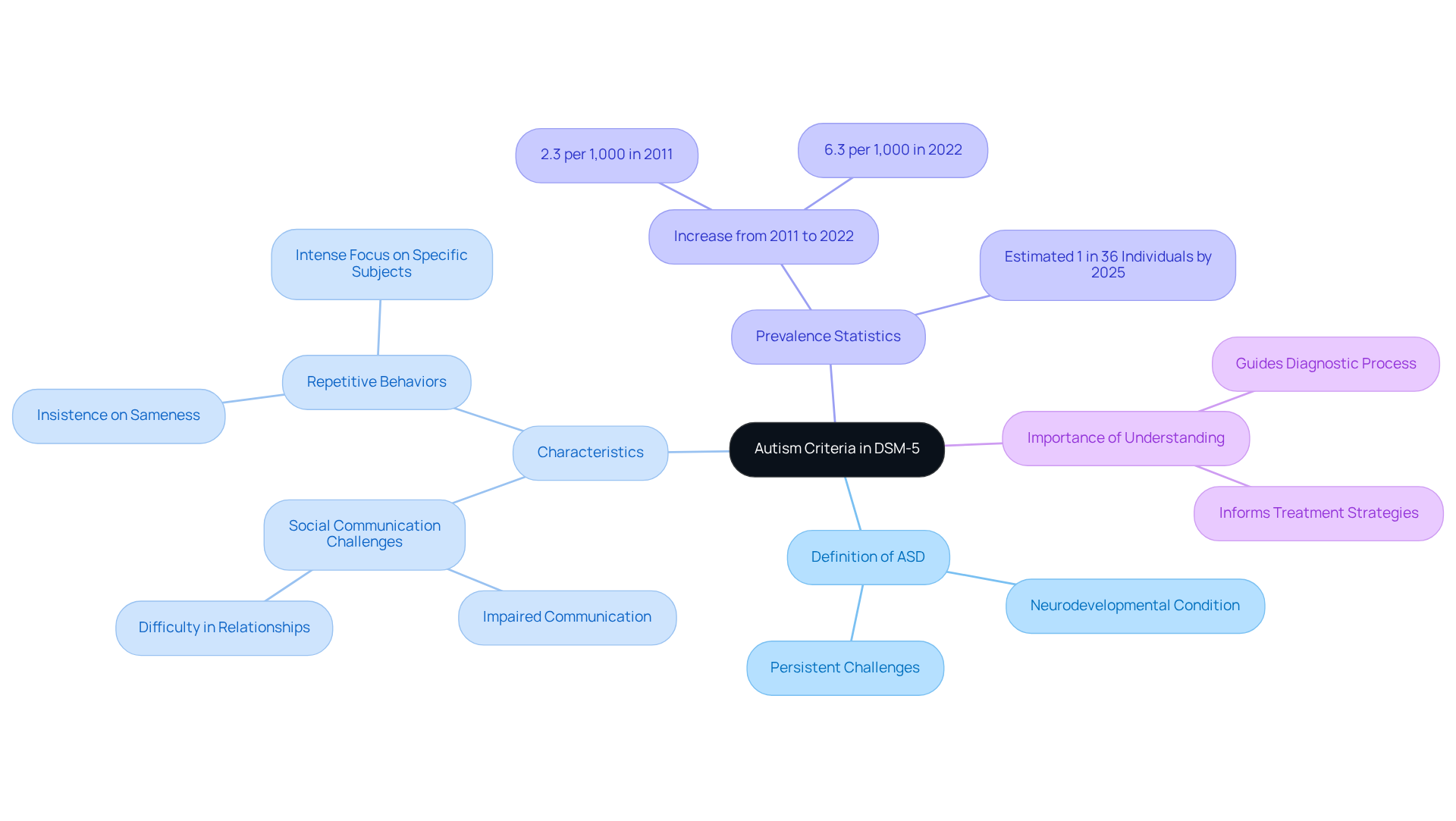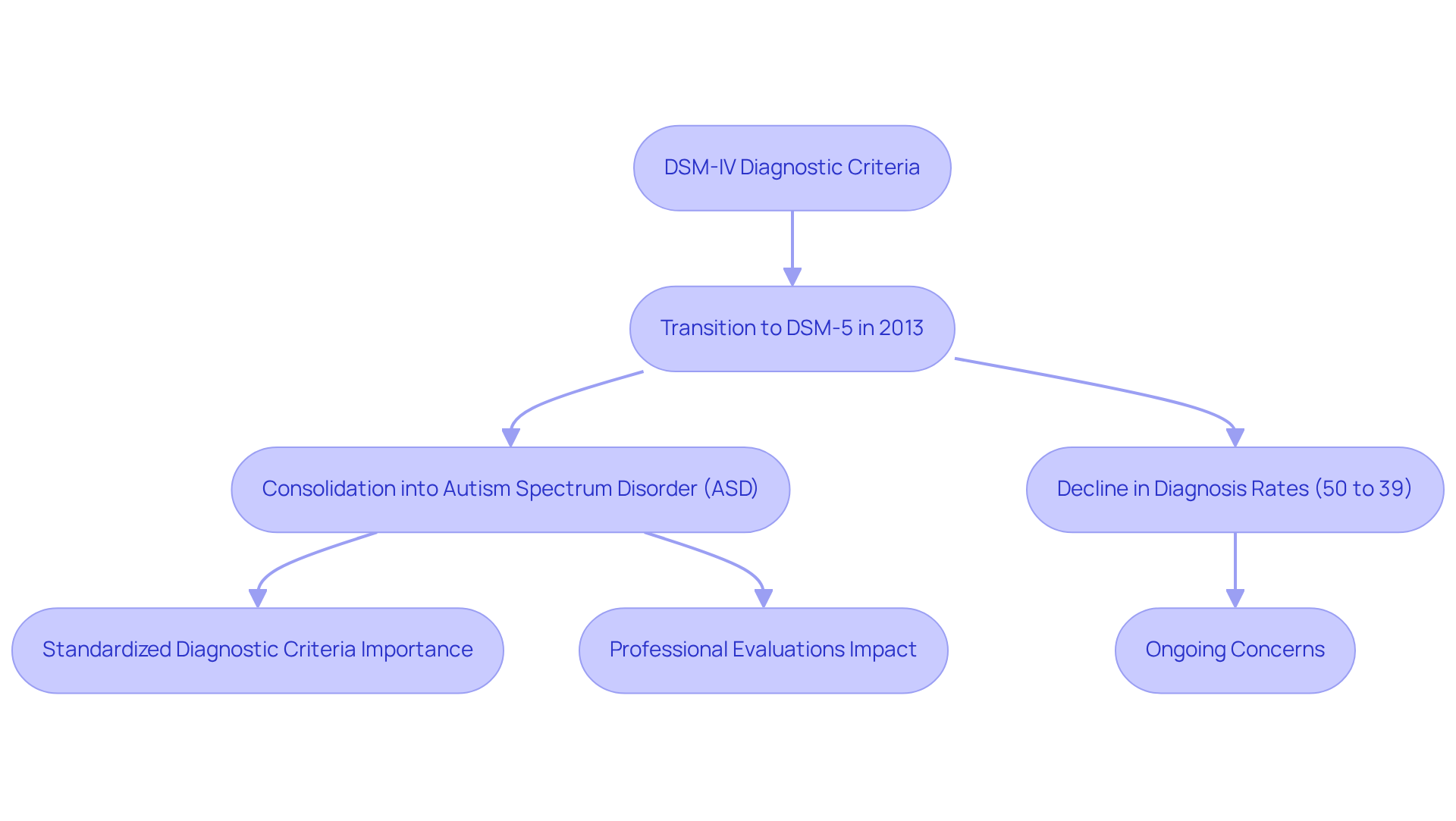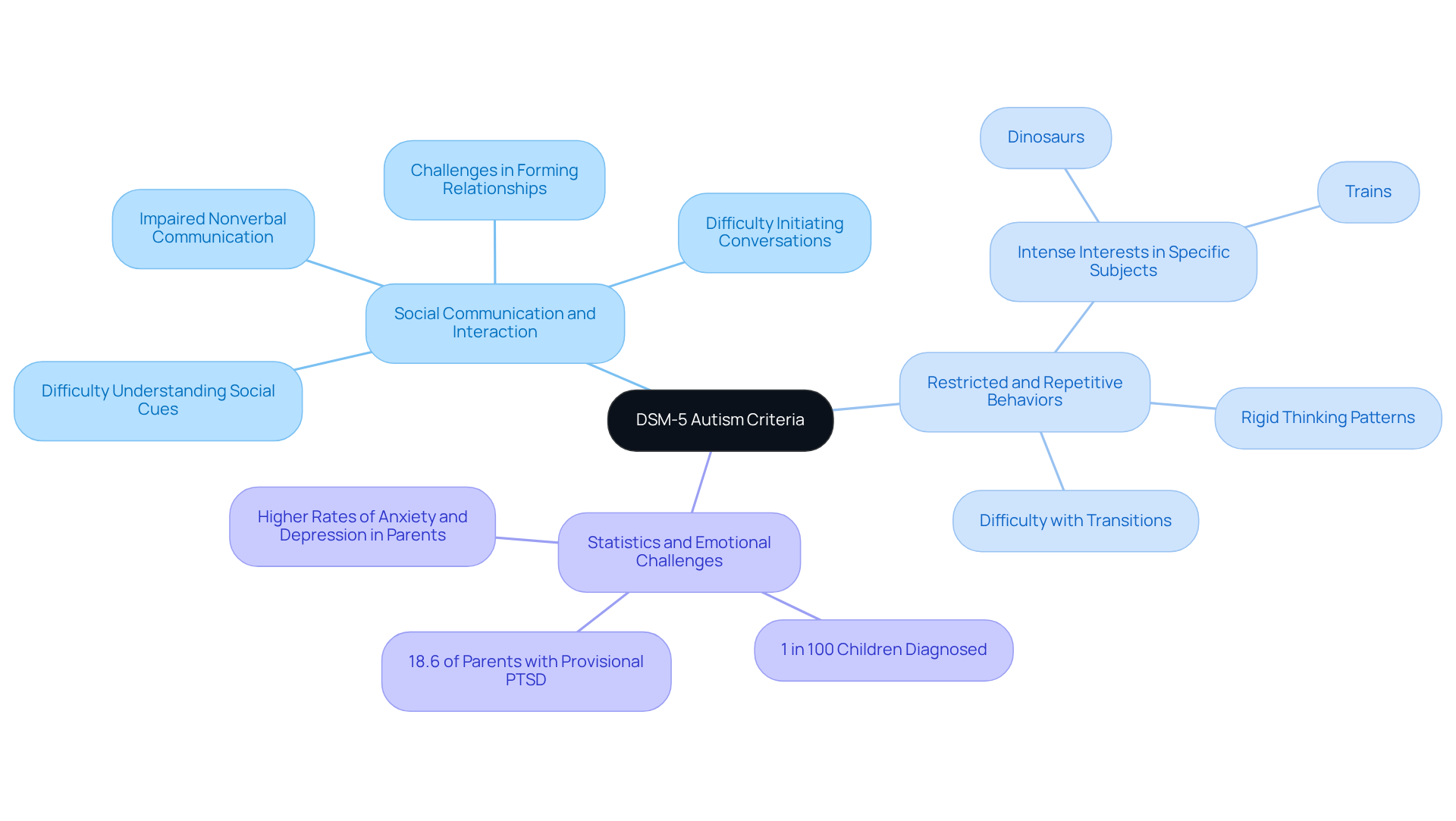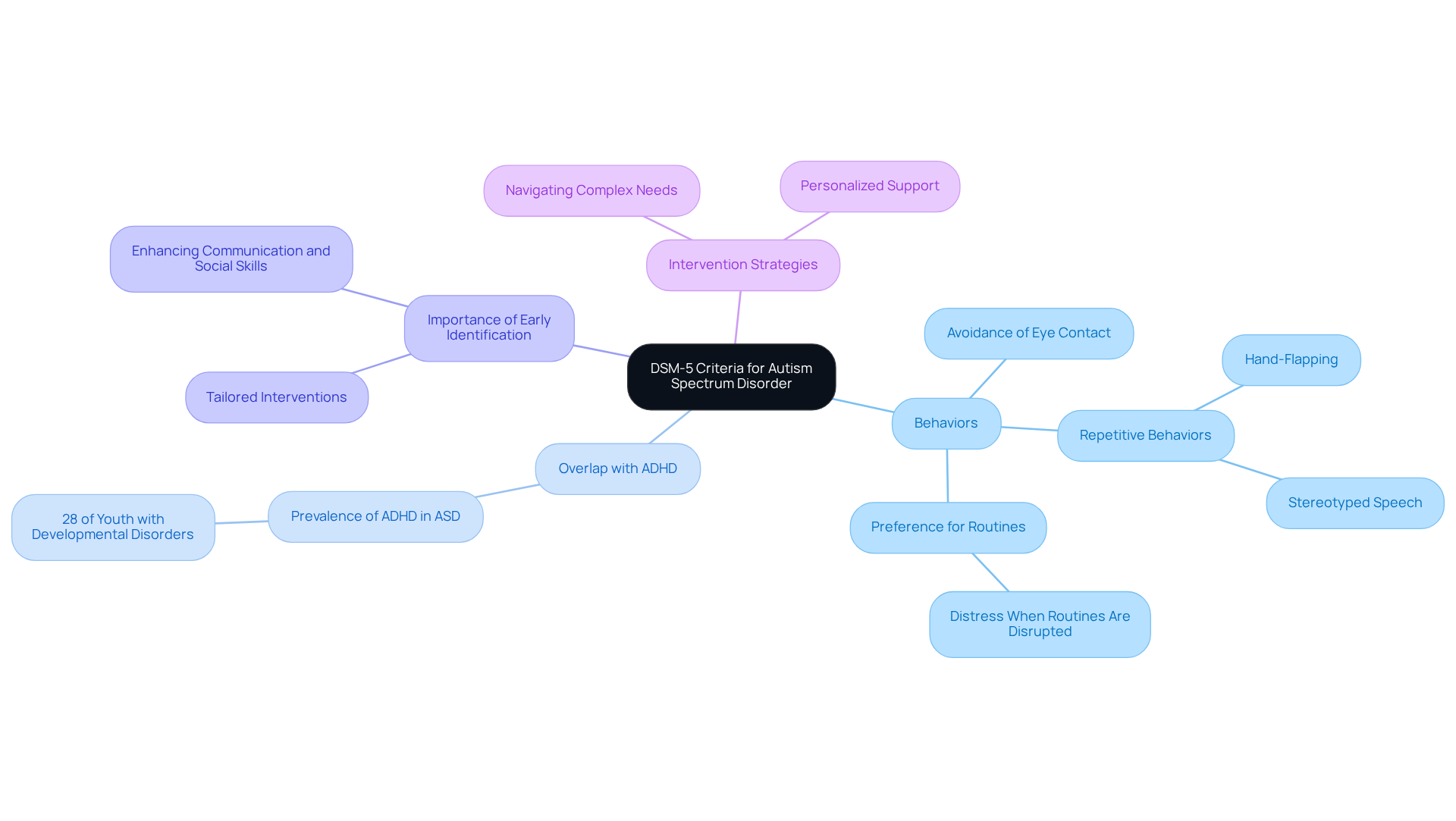Overview
This article highlights the autism criteria outlined in the DSM-5, defining autism spectrum disorder (ASD) as a neurodevelopmental condition. It’s characterized by challenges in social communication and interaction, alongside restricted and repetitive behaviors. Understanding these criteria is vital for parents. It empowers them to identify early signs of ASD, enabling timely interventions that can significantly improve outcomes for their children.
As parents, you may feel overwhelmed by the complexities of ASD. It’s natural to have concerns about your child’s development. Recognizing the signs early can make a profound difference. Imagine being able to connect with resources and support systems that can guide you through this journey.
We encourage you to explore available support options. By seeking help and information, you are taking important steps towards ensuring a brighter future for your child. Remember, you are not alone in this; many parents share similar experiences and challenges. Together, we can foster understanding and compassion in our communities.
Introduction
Understanding autism spectrum disorder (ASD) is increasingly vital, especially as its prevalence continues to rise. Projections indicate that by 2025, 1 in 36 individuals will be diagnosed. This statistic is not just a number; it represents countless families navigating the challenges of ASD. The DSM-5 plays a crucial role in this context, providing standardized criteria that shape the diagnostic process and inform effective treatment strategies for families seeking support.
However, the transition from previous diagnostic frameworks has sparked important discussions. Parents may wonder about the implications for identification and support. Are the current criteria truly meeting the diverse needs of children with autism? These questions are essential as we strive to ensure that every child receives the understanding and resources they deserve. By fostering open conversations and sharing experiences, we can build a supportive community that addresses these concerns together.
Define Autism Criteria in DSM-5
The autism criteria DSM 5 in the Diagnostic and Statistical Manual of Mental Disorders, Fifth Edition, identifies autism spectrum disorder (ASD) as a neurodevelopmental condition. This condition is marked by persistent challenges in social communication and interaction, alongside restricted and repetitive behaviors, interests, or activities. For parents and caregivers, understanding this definition is crucial; it not only guides the diagnostic process but also informs treatment strategies. Early signs of ASD typically emerge in developmental stages, although they might not be fully recognized until social demands surpass an individual's abilities.
In 2025, it is estimated that around 1 in 36 individuals will be identified with ASD. This statistic highlights a significant increase in prevalence—from 2.3 per 1,000 people in 2011 to 6.3 per 1,000 people in 2022. Such a rise underscores the urgent need for early intervention. Many children diagnosed with ASD exhibit behaviors such as insistence on sameness and intense focus on specific subjects, which are consistent with the autism criteria DSM 5.
Experts stress the importance of understanding the autism criteria DSM 5 to ensure accurate diagnoses and provide effective support for children and families navigating the complexities of developmental disorders. By fostering a deeper understanding of ASD, we can work together to create a supportive environment for those affected. If you have experiences or insights to share, please consider joining our community discussions or reaching out for resources that can help you and your family.

Explore the Historical Context and Importance of DSM-5 Criteria
The release of the DSM-5 in 2013 marked a pivotal moment in how we assess developmental disorders, particularly in relation to autism criteria DSM 5. It moved away from the previous DSM-IV framework, which categorized conditions like autistic disorder, Asperger's disorder, and pervasive developmental disorder not otherwise specified (PDD-NOS). Instead, the autism criteria DSM 5 consolidated these conditions into a single diagnosis known as autism spectrum disorder (ASD). This shift reflects a deeper understanding of autism as a spectrum, encompassing a variety of symptoms and severity levels. For parents and professionals, this historical change underscores the importance of standardized diagnostic criteria, such as the autism criteria DSM 5, to ensure accurate identification and effective intervention strategies.
Insights from experts reveal that the transition from DSM-IV to DSM-5, particularly regarding the autism criteria DSM 5, has significant implications for diagnosis rates. Research indicates a notable decline in autism diagnoses following the introduction of the DSM-5 guidelines, with rates dropping from 50% under DSM-IV to approximately 39% under DSM-5 between 2013 and 2015. Matthew J. Maenner noted that children identified by community experts were more likely to meet the autism criteria DSM 5, which highlights the crucial role of professional evaluations in determining prevalence rates. This decline raises valid concerns about the risk of overlooked diagnoses and the ongoing need for vigilance in identifying young individuals who may require support.
Case studies further illustrate the effects of these changes. One study found that young individuals recognized by community specialists were more inclined to meet the autism criteria DSM 5, emphasizing the significant impact of professional evaluations on prevalence rates. Another case study examined the effects of the updated standards on prevalence estimates, revealing that 81.2% of youth met the autism criteria DSM 5 during the 2006 and 2008 monitoring years, indicating a shift in diagnostic practices.
Overall, the transition to the new diagnostic manual not only reflects advancements in our understanding of developmental disorders but also highlights the importance of adapting diagnostic practices to ensure that every young person receives the necessary support. However, mixed evaluations regarding the changes to the diagnostic manual persist, with some specialists cautioning that the stricter criteria may leave more young individuals without essential services. This ongoing dialogue underscores the need for continued research and adaptation in the field, as we strive to provide the best possible care for our children.

Detail Key Characteristics of DSM-5 Autism Criteria
Understanding autism is crucial for parents, as it can significantly impact their child's development. The autism criteria DSM 5 outlines two main areas of dysfunction that are essential for diagnosing the condition: social communication and interaction, alongside restricted and repetitive behaviors. Within these domains, parents may notice significant difficulties in their child’s ability to understand and respond to social cues, as well as challenges in forming and maintaining relationships. For instance, a young person might struggle to initiate conversations or may display intense interests in specific subjects like dinosaurs or trains.
Recognizing these characteristics early is vital, as this condition is typically identified within the first two years of life. Early detection paves the way for effective intervention, which can make a world of difference. Did you know that roughly 1 in 100 youngsters globally has this condition? This statistic underscores the importance of awareness among guardians.
Additionally, many children with developmental disorders may face concurrent issues such as anxiety and ADHD, complicating their overall growth. Identifying these traits is essential for parents, as it empowers them to advocate effectively for their child's needs and navigate the complexities of autism support services. Moreover, it’s important to acknowledge that 18.6% of parents of autistic individuals qualify for a provisional diagnosis of PTSD. This statistic highlights the emotional challenges that families encounter.
Understanding these traits is essential for diagnosing according to the autism criteria DSM 5 and serves as crucial indicators for parents to comprehend their child’s behavior. By recognizing these signs, parents can seek suitable support and resources, ensuring their child receives the care they deserve. Sharing experiences and insights can also foster a supportive community, helping others navigate their journeys with autism.

Provide Examples of DSM-5 Criteria in Practice
Real-life situations beautifully illustrate the DSM-5 standards for autism spectrum disorder. Consider a young person who consistently avoids eye contact, struggles to engage in reciprocal conversations, and displays repetitive behaviors like hand-flapping; this exemplifies the diagnostic criteria. Another scenario features a young individual with a strong preference for routines, who becomes visibly distressed when those routines are disrupted, illustrating the insistence on sameness as outlined in the autism criteria DSM 5. It's important to note that statistics indicate around 28% of youth with developmental disorders also encounter attention deficit hyperactivity disorder (ADHD), complicating their behavioral profiles. This overlap makes it crucial for parents to identify these traits early on.
Many parents share their experiences, highlighting how recognizing these behaviors was essential in seeking appropriate support. Case studies underscore the importance of understanding these traits, as early identification can lead to personalized interventions that enhance communication and social skills, ultimately improving the individual's quality of life. Moreover, understanding the varying levels of support required for children with autism can empower parents to navigate the complexities of their child's needs, ensuring they receive the appropriate resources and interventions. Together, we can foster an environment that nurtures growth and understanding.

Conclusion
Understanding the autism criteria outlined in the DSM-5 is essential for parents and caregivers navigating the complexities of autism spectrum disorder (ASD). This framework not only provides a clear definition of ASD but also emphasizes the importance of early diagnosis and intervention. By grasping these criteria, families can better advocate for their children and seek the support necessary for their development.
The article delves into the historical context of the DSM-5's criteria, highlighting the shift from previous classifications to a unified understanding of autism as a spectrum. It explores the key characteristics that define ASD, such as challenges in social communication and repetitive behaviors, and underscores the significance of early recognition. Furthermore, real-life examples illustrate how these criteria manifest in everyday situations, reinforcing the need for awareness and understanding among parents.
Ultimately, fostering a supportive environment for children with autism hinges on informed awareness and proactive engagement. By understanding the DSM-5 criteria, parents can navigate the diagnostic process more effectively and connect with resources that enhance their child's quality of life. Sharing experiences and insights within the community can further empower families, ensuring that every child receives the necessary support to thrive.
Frequently Asked Questions
What is the definition of autism spectrum disorder (ASD) according to the DSM-5?
The DSM-5 defines autism spectrum disorder (ASD) as a neurodevelopmental condition characterized by persistent challenges in social communication and interaction, along with restricted and repetitive behaviors, interests, or activities.
Why is understanding the autism criteria in the DSM-5 important for parents and caregivers?
Understanding the autism criteria is crucial for parents and caregivers as it guides the diagnostic process and informs treatment strategies for children with ASD.
When do early signs of ASD typically emerge?
Early signs of ASD usually emerge during developmental stages, although they may not be fully recognized until social demands exceed the individual's abilities.
What is the estimated prevalence of ASD by 2025?
By 2025, it is estimated that approximately 1 in 36 individuals will be identified with ASD.
How has the prevalence of ASD changed from 2011 to 2022?
The prevalence of ASD has significantly increased from 2.3 per 1,000 people in 2011 to 6.3 per 1,000 people in 2022.
What behaviors are commonly exhibited by children diagnosed with ASD?
Many children diagnosed with ASD exhibit behaviors such as insistence on sameness and intense focus on specific subjects.
What do experts emphasize regarding the autism criteria in the DSM-5?
Experts emphasize the importance of understanding the autism criteria to ensure accurate diagnoses and provide effective support for children and families dealing with developmental disorders.
How can individuals contribute to the understanding of ASD within their communities?
Individuals are encouraged to share their experiences or insights and participate in community discussions or seek resources that can assist families affected by ASD.




